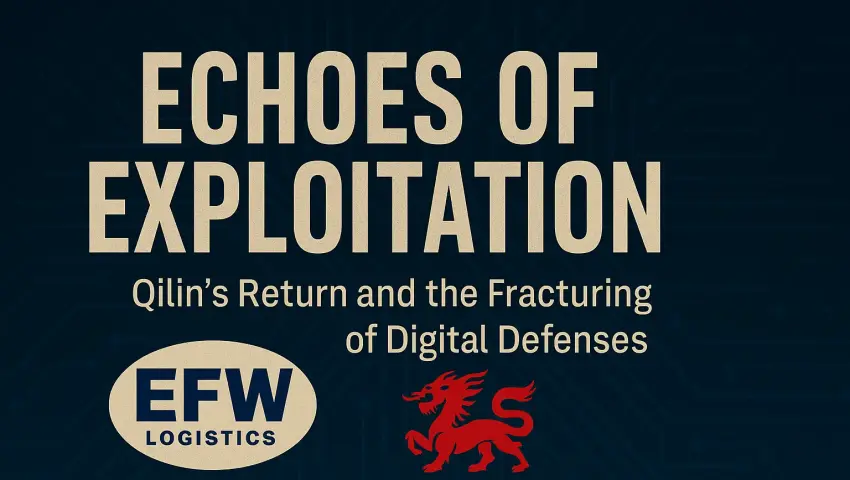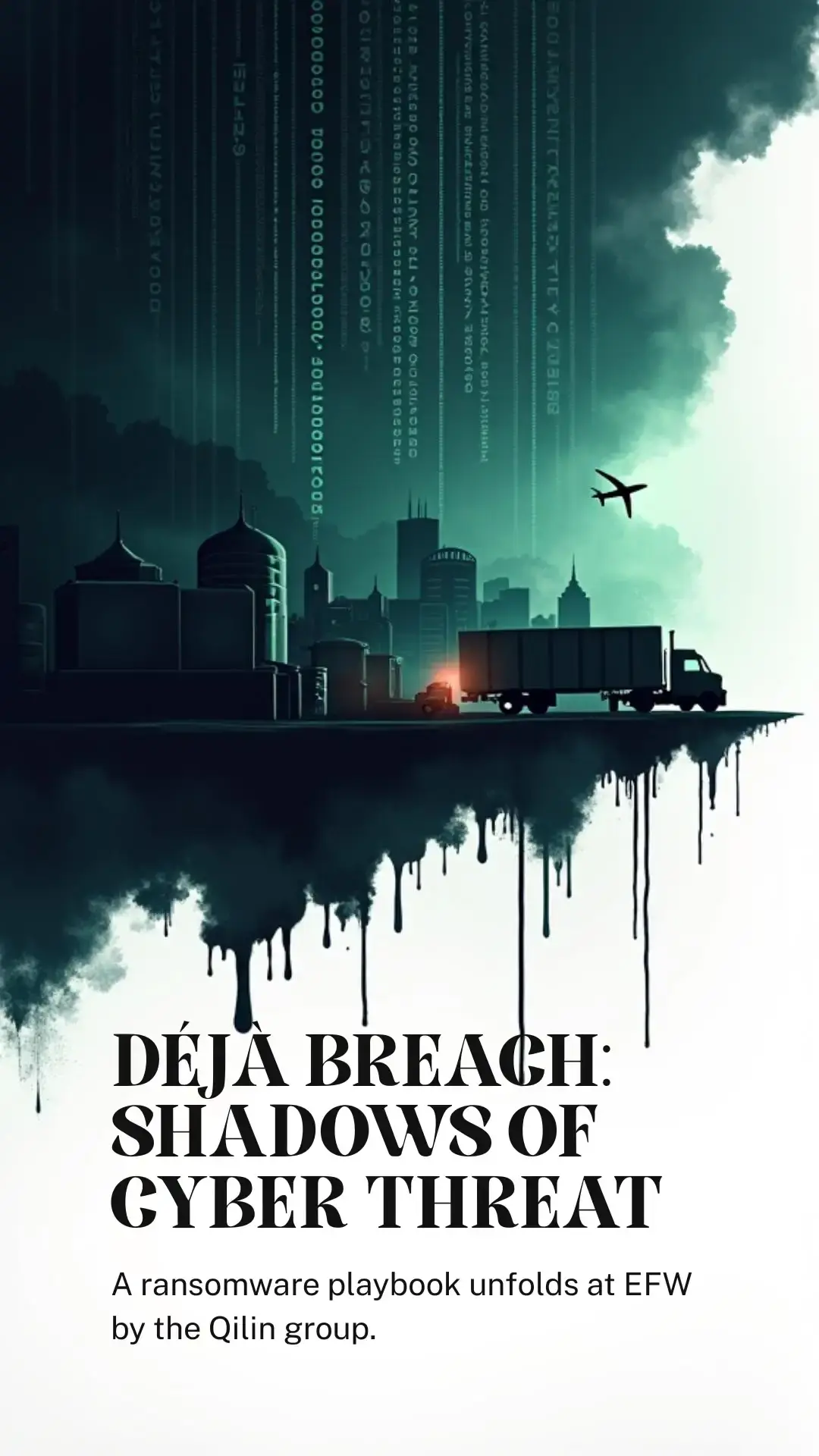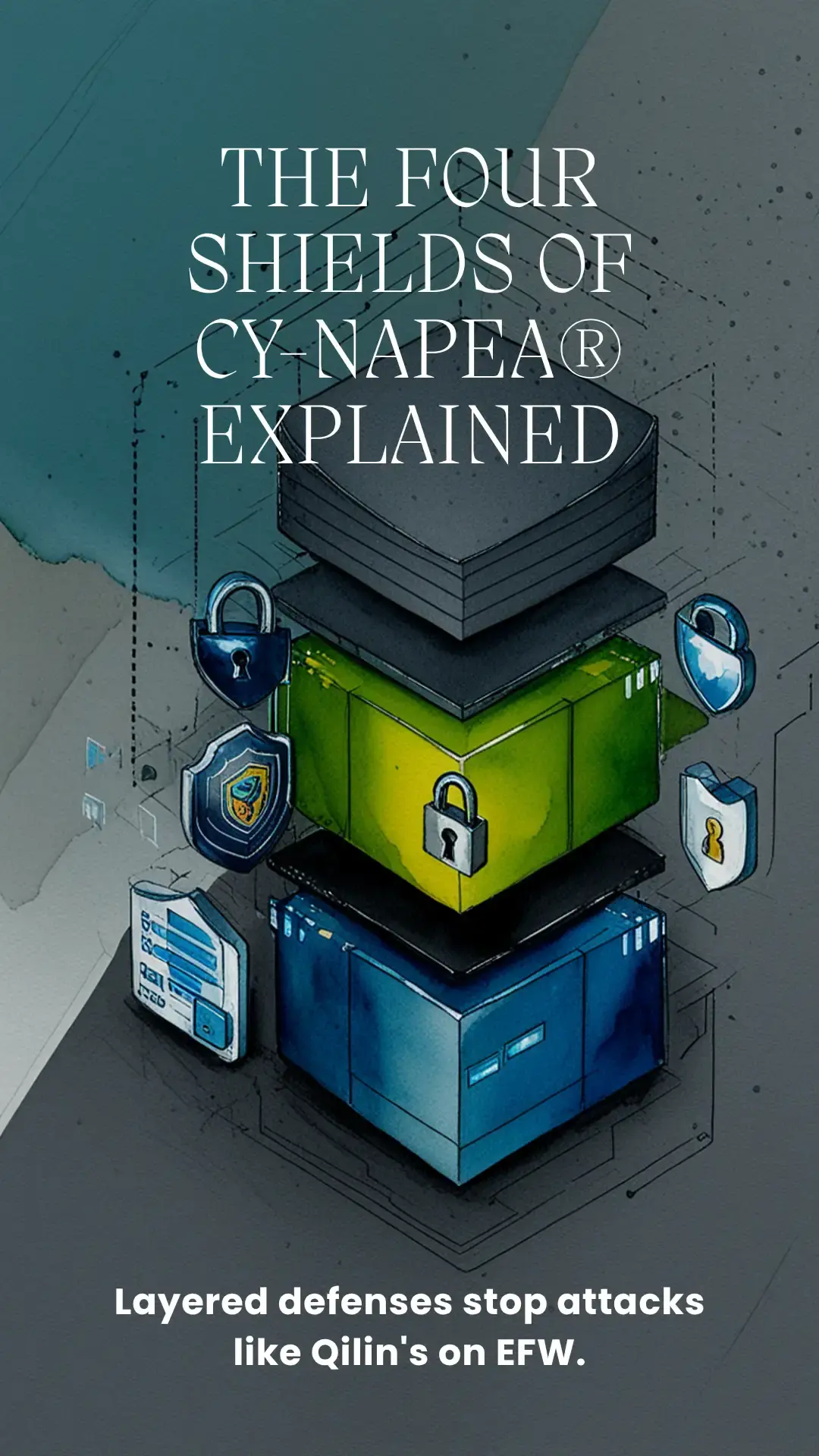
Echoes of Exploitation: Qilin’s Return and the Fracturing of Digital Defenses
Déjà Breach – When Shadows Return
They came again.
Only this time, the message wasn’t just encrypted code or a locked screen—it was a whisper through the wires: “Call your lawyer.” The same chilling phrase that marked Qilin’s psychological siege on Fabbri Group now echoed through the digital corridors of Estes Forwarding Worldwide (EFW).

EFW isn’t just another logistics company. It’s a high-touch freight forwarding powerhouse, headquartered in Richmond, Virginia, and backed by Estes—the largest privately held freight transportation network in North America. With over 1,000 professionals, 7 million square feet of warehouse space, and a global network spanning Asia, Europe, and the Americas, EFW moves more than cargo—it moves trust.
And that trust was breached.
On May 28, 2025, EFW became the latest victim of Qilin, a Russian-speaking ransomware syndicate that has evolved from mere data extortionists into digital tormentors. Originally known as “Agenda,” Qilin operates as a ransomware-as-a-service (RaaS) platform, offering affiliates a customizable toolkit to infiltrate, encrypt, and extort. Their tactics are brutal and refined: double extortion, psychological manipulation, and public shaming via leak sites.
This wasn’t Qilin’s first act. They’ve hit hospitals in London, construction firms in the U.S., and even humanitarian organizations. But with EFW, they struck a company whose business depends on precision, reliability, and discretion. And they knew it.
The breach didn’t halt planes or trucks. But it did something more insidious: it exposed employee passports, driver’s licenses, and sensitive logistics data—a calculated move to erode confidence and sow chaos from within.
If our previous article chronicled Qilin’s transformation into psychological predators, this attack proves it wasn’t a one-off. It was a template. A playbook. And EFW was the next chapter.
The Clock Struck Late – A Timeline of Silence and Shock
For nearly a month, the breach at Estes Forwarding Worldwide (EFW) simmered beneath a surface of corporate calm. But on June 27, 2025, the silence shattered. The Qilin ransomware gang had already made their move weeks earlier—on May 28—but it wasn’t until their dark web leak site lit up with stolen EFW data that the company was forced to go public.
Why now? Because Qilin made it impossible to stay quiet.
The attack began with stealth. Qilin likely exploited a known vulnerability in backup infrastructure, such as the CVE-2023-27532 flaw in Veeam, or used phishing and credential stuffing to gain access. Once inside, they moved laterally, encrypted systems, and exfiltrated sensitive data—passports, driver’s licenses, internal logistics spreadsheets—before delivering their signature psychological payload: “Call your lawyer.”
EFW’s IT teams acted fast. Systems were isolated, backups restored, and operations continued with minimal disruption. But the real damage wasn’t in downtime—it was in data exposure and regulatory fallout.
Because this wasn’t just a cyberattack. It was a legal and compliance crisis.

EFW now faces scrutiny under multiple frameworks:
U.S. FTC Safeguards Rule and Section 5 of the FTC Act, which demand reasonable data protection practices.
OFAC regulations, if any ransom was paid to a sanctioned entity.
GDPR, if any EU citizens’ data was compromised—triggering a 72-hour breach notification requirement and potential fines up to €20 million or 4% of global turnover.
And now, the sharpened blade of NIS2.
The NIS2 Directive, Europe’s updated cybersecurity law, casts a wider net over critical sectors—including transport and logistics providers like EFW. If EFW handles EU-bound freight or stores data on European citizens, it may fall under NIS2’s jurisdiction. And the penalties? They’re designed to sting:
For essential entities (like major logistics firms), fines can reach €10 million or 2% of global annual revenue, whichever is higher.
For important entities, the ceiling is €7 million or 1.4% of global revenue.
But it doesn’t stop at money. NIS2 empowers regulators to impose non-monetary sanctions, including public reprimands, mandatory audits, and even personal liability for executives in cases of gross negligence.
The timeline tells a story of speed and silence. But the laws tell a story of responsibility—and the consequences of delay.
Freight, Fear, and the Cost of Silence
The planes didn’t stop. The containers kept rolling. And from the outside, Estes Forwarding Worldwide (EFW) looked unshaken. But behind boardroom doors and encrypted inboxes, the true damage was unfolding—not in grounded cargo, but in regulatory crosshairs, financial fallout, and broken trust.
So, how much does a modern ransomware attack like Qilin’s actually cost?
Let’s look at the facts:
Based on IBM’s 2024 Cost of a Data Breach report, transportation-sector breaches average $4.4 million.
With the leaked personal data (passports, licenses), plus cross-border exposure and regulatory risk, EFW’s total estimated loss may climb to $6.1–8.5 million, including:
Incident response & forensics: $600K
Legal & regulatory liability (GDPR, NIS2, FTC, OFAC): $1.5–2.5 million
Customer churn & reputational harm: $2–3 million
Cyber insurance gaps & rate increases: $500K–1 million
Internal resource drain & IT overtime: $1–1.5 million
And then there are the penalties—no longer hypothetical:
GDPR fines can hit €20 million or 4% of global annual revenue, whichever is higher, for delays in breach disclosure or inadequate data safeguards.
Under NIS2, which now covers critical sectors including logistics, fines can soar to:
€10 million or 2% of global turnover for essential entities
€7 million or 1.4% for important entities
And if ransom payments touched sanctioned networks (like Qilin’s suspected affiliations), OFAC could add civil or criminal exposure.
In short: the price of silence may be far costlier than the breach itself.
The Four Shields of Cy-Napea®: Ransomware Meets Its Match

At Cy-Napea®, we approach cyber resilience with layered precision—not just guarding against attacks, but ensuring that no single failure means collapse. EFW’s attack aligned almost perfectly with known threats. Here’s how our model would have intercepted it:
Cybersecurity Awareness Training
Purpose: Empower employees to detect phishing and social engineering—Qilin’s most common entry point.
Impact: Prevention at the human level, reducing the risk of accidental compromise before malware ever loads.
Advanced Email Security
Purpose: Deploy deep email filtering, link rewriting, and attachment sandboxing.
Impact: Neutralize malicious payloads before they reach the user—cutting off the infection at its source.
EDR/XDR/MDR with Patch Management
Purpose: Detect lateral movement and block exploit kits like Qilin’s, especially around vulnerabilities such as CVE-2023-27532 (Veeam).
Impact: Accelerated detection and rapid containment across endpoints, servers, and cloud.
Immutable Storage & Secure Backup
Purpose: Ensure offline, tamper-proof backups resistant to deletion or encryption—even by rogue insiders.
Impact: Fast restoration with zero ransom, preserving operations and regulatory standing.
Qilin weaponized uncertainty. Cy-Napea® arms you with certainty.
Before they encrypt your assets, fortify your trust. Before they breach your walls, build unbreakable layers.
Disclosure and Methodology
This article series, including all financial estimates, regulatory interpretations, and strategic defense recommendations, has been constructed using publicly available information, historical precedent, and confirmed disclosures from Estes Forwarding Worldwide (EFW) as of June 27, 2025.
All monetary loss estimates presented in the article are hypothetical and illustrative, modeled on past incidents—including comparable ransomware attacks in the logistics sector—and reports from industry sources such as IBM Security and regulatory enforcement bodies. No internal data from EFW was accessed, and no non-public assessments have been included.
The references to legal frameworks such as GDPR, NIS2, OFAC, and the FTC Safeguards Rule are based on current published statutes and regulatory guidelines as of the date of writing. Any analysis of potential non-compliance or fines is speculative, intended to educate and inform—not to serve as legal advice or definitive assessment.
EFW’s involvement, as discussed throughout the series, is based entirely on facts disclosed by the company itself and corroborated by credible public reporting. No claims are made beyond what is supported by evidence released through official communications, threat intelligence platforms, or statements from Qilin and other involved parties.
Sources and References:
EFW public disclosure (June 27, 2025)
Qilin ransomware leak site and historical attack footprint
IBM Security "Cost of a Data Breach Report 2024"
European Union Agency for Cybersecurity (ENISA): NIS2 Directive Overview
European Commission: General Data Protection Regulation (GDPR) text
U.S. Federal Trade Commission: Safeguards Rule and Section 5 guidance
U.S. Department of the Treasury: OFAC Sanctions Advisory on Ransomware
Veeam CVE-2023-27532 vulnerability bulletin
Previous public incidents: KNP Logistics (2023), Fabbri Group (2025), and various Qilin campaigns




